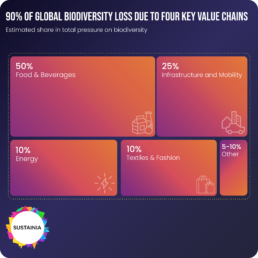Sustainia Simplifies
Biodiversity and Corporate Sustainability

The Interplay Between Biodiversity and Corporate Sustainability: Risks, Opportunities and Action
Today’s businesses largely rely on biodiversity, whether for raw material inputs, ecosystem services such as pollination and water regulation, or indirectly through their supply chains. Indeed, the World Economic Forum (WEF) estimates that more than half of the world’s total GDP, approximately $44 trillion, is dependent on natural capital assets and ecosystem services. At the same time, businesses also largely account for man-made pressures on biodiversity, threatening habitats and species diversity through direct overexploitation, pollution, and land conversion. As a result, biodiversity loss poses substantial risks for businesses and presents immense opportunities with far-reaching implications.
The Impact of Biodiversity on Corporations
Although activities driving biodiversity loss can be traced back to every value chain, there are four that stand out: food and beverages, infrastructure and mobility, energy, as well as textiles and fashion. According to Boston Consulting Group (BCG), these four value chains are responsible for approximately 90% of global biodiversity loss, with the food and beverages sector taking the lead by contributing to over 50% of the current pressures on biodiversity. Conversely, as ecosystems decline, these businesses are among the first to face the consequences. Over three-quarters of global food crops rely on natural pollinators, and at least half of apparel is cotton-based. At the same time, the built spaces through which we live, work, and produce energy depend on healthy ecosystems for climate regulation, erosion prevention, and flood control.
Such risks as those mentioned above—related to resource scarcity, natural hazards, and ecosystem services—represent physical risks directly threatening value chains that depend on biodiversity. However, as the World Wildlife Fund (WWF) describes in the guidance report published last year, biodiversity-related risks further include those emerging from the transition to a nature-positive economy, which primarily pose threats to those businesses that fail to adapt.
In light of increasing global and regional initiatives related to biodiversity, regulatory risks can impose significant business costs through operating restrictions, the taxation of harmful activities, or even fines for failing to adjust business operations. For example, the EU Green Deal, EU regulation on deforestation-free products, EU Nature Restoration Law (still in development), and the Convention on Biological Diversity are crucial drivers reshaping the corporate landscape, demanding that businesses align their practices with biodiversity conservation. As regional and international treaties evolve, they will be translated and adopted into EU member states’ legislations, ultimately shaping conduct concerning biodiversity and holding corporate endeavors accountable for their environmental impacts.
Besides pressures from governmental regulations, public awareness of biodiversity issues can translate into reputational risk when businesses are faced with a tarnished reputation among customers and stakeholders, eventually leading to a loss in brand value and difficulties in soliciting funding. Finally, all aforementioned risks may result in market risks as resources become scarce, input prices spike, or market competitors gain more traction for their biodiversity efforts.
The Business Case for Biodiversity
While the unfolding biodiversity agenda creates significant business risks, it also fosters real opportunities. In fact, business opportunities from making investments with nature-positive outcomes could amount to $10 trillion annually and create as many as 395 million jobs by 2030, according to the WEF. For those at the forefront of biodiversity action, these opportunities are particularly beneficial in improving customer and investor confidence as well as opening doors into profitable new markets.
As it turns out, a recent BCG survey of 3,000 people found that most respondents—88% to be precise—expect companies to integrate environmental concerns into their operations. To do so, companies can support the conservation or restoration of specific places they operate or whose ecosystem services they depend upon. For example, energy company Ørsted has launched several biodiversity projects and partnerships together with WWF and others to monitor migration patterns, restore biogenic reefs, or support natural coral growth on the foundations of their offshore wind turbines, with the overarching objective of restoring biodiversity in or surrounding their operating sites.
The opportunities do not stop there. Companies can develop biodiversity-friendly products and value chains that meet existing markets’ needs or open up new markets. Alternatively, changing internal practices in favor of biodiversity can reduce production costs down the line, whether by improving efficiency in resource use or by recovering and reusing byproducts of manufacturing processes to help reduce waste and input costs. Moreover, companies may even earn a return on their investments in preserving or restoring ecosystem services through investors and various regulatory frameworks adopted by governments.
Perhaps the most prevalent example at the time of writing is Patagonia’s environmental responsibility and animal welfare programs. Breaking through with the news that the company’s ownership has been transferred to a trust and a nonprofit organization, all profits will now be directed towards combating climate change and protecting undeveloped land. Besides this, the company is continually working towards establishing traceability of their materials and implementing supplier guidelines; striving to only use organic and regenerative organic cotton, hemp, and recycled materials by 2025; and achieving 100% reusable, compostable, or recyclable packaging.
Similar efforts are emerging in the other value chains, as well. Regarding the food and beverages industry, Nestlé has committed to sourcing half of their key ingredients through regenerative agriculture by 2030. Additionally, the company supports farmers in reducing chemical fertilizers, improving species diversity and adding green buffers to their fields. Ferrovial, a global infrastructure operator, is further extending its biodiversity policy to all subcontractors while monitoring the impact of infrastructures on biodiversity and investing in nature-based solutions such as forest restoration in degraded areas.
Materiality: Integrating ESG Metrics into Biodiversity
At the core of environmental sustainability, the intersection of ESG metrics and biodiversity emerges as a crucial focal point. Recognizing the urgency of addressing biodiversity loss, corporations must now measure and disclose biodiversity-related information using key performance indicators (KPIs). Under biodiversity, these indicators range from employee biodiversity awareness and conservation efforts to sustainable sourcing and ecosystem services, depending on how they affect corporations’ business operations and vice versa.
The efficacy of the reporting process lies in the adoption and integration of renowned frameworks such as the Global Reporting Index (GRI), Corporate Sustainability Reporting Directive (CSRD), Taskforce on Climate-related Financial Disclosures (TCFD), and the Taskforce on Nature-related Financial Disclosures (TFND) which act as reliable tools to capture biodiversity-related risks and opportunities. The TNFD is especially noteworthy as far as voluntary, specific biodiversity disclosures go.
By adhering to these robust frameworks, companies can holistically assess their impact on biodiversity, identify potential vulnerabilities, and implement effective sustainability strategies. Furthermore, investors increasingly regard biodiversity materiality as a critical factor influencing their investment decisions, steering capital towards organizations committed to preserving and enhancing biodiversity.
As biodiversity loss poses significant risks across industries, forward-thinking companies must acknowledge the imperative to act in harmony with nature. Embracing biodiversity preservation offers multifaceted opportunities, from enhancing brand value and accessing new markets to achieving cost savings and attracting investor confidence. Corporations can drive positive change and create a sustainable legacy by integrating ESG metrics into biodiversity considerations and adopting robust reporting frameworks. In this era of heightened awareness and transformative regulations, collective action toward biodiversity conservation is the key to unlocking a prosperous and resilient future for both corporations and the planet.
